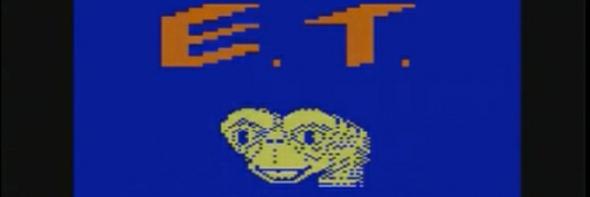
Claim: Atari buried millions of unsold E.T. game cartridges in a New Mexico desert landfill.
Origins: In 1982, Warner Communications could honestly claim to own a goose that laid golden eggs. Its money-producing fowl was called Atari, a video game company it purchased for

earnings predicted a 50% increase over the previous year.
The goose died at
What accounted for the sudden death of Warner's prized goose? A number of interrelated factors brought about its fatal illness:
- Most of Atari's top programmers, disenchanted with the lack of respect, compensation, and freedom they were afforded under Warner management, left to work elsewhere.
- Atari was selling its game consoles as cheaply as possible and expecting to make its profits from sales of game cartridges, but other companies such as Imagic and Activision (founded by some of the disenchanted Atari programmers mentioned above) cut into Atari's sales by creating their own cartridges for Atari consoles (and their games were far superior to what Atari itself was producing).
- Atari's VCS game console was several years old by 1982, and its established customer base was being eroded by newer, better systems such as Mattel's Intellivision and Coleco's ColecoVision (especially when those systems started offering adapters that allowed customers to play VCS game cartridges without needing to own Atari consoles). Even worse, the "next generation" system Atari finally unveiled in late 1982 ,the
Atari 5200, was a huge disappointment (in part because its joysticks were poorly designed and difficult to use, and because it was incompatible with the huge existing base of VCS cartridges). - Atari's home consumer division had garnered huge profits by producing home versions of popular arcade games created by its own
coin-op division (Asteroids) or licensed from other manufacturers (Taito's Space Invaders and Namco's Pac-Man), but let the licensing of that year's smash arcade hit, Donkey Kong, slip away from them. (The license for Donkey Kong was instead snapped up by Coleco, who probably could not have successfully launched its competing ColecoVision game system without it.)
The first signs of the goose's fatal illness came with Atari's
The result backfired on Atari by causing consumers to behave differently when purchasing games. There was already a growing mass of new low quality third party 'spam' titles on the market, and now with the experience of from rushing to buy
If one game cartridge could be selected as the symbol of the sudden demise of Atari's golden goose, however, it would have to be the ill-fated E.T.: The Extraterrestrial game. Steve Ross, the head of Warner Communications, made a deal with Steven Spielberg to produce a home video game version of Spielberg's blockbuster E.T. film. Basing a video game on a movie rather than an established arcade hit or a tested game premise and expecting it to sell simply because of the popularity of the film might have been a questionable enough decision on its own (although Atari did enjoy moderate success with its video game version of Spielberg's previous

blockbuster, Raiders of the Lost Ark), but on top of that Ross forked over a whopping
The sheer awfulness of the finished product was unprecedented. Atari rushed E.T. through development in a matter of weeks to get it onto the market in time for Christmas, and the result was something many consumers found to be a virtually unplayable game with a dull plot and crummy graphics in which frustrated players spent most of their time leading the E.T. character around in circles to prevent him from falling into pits. Atari produced
In total, five million copies of E.T. were produced. Initially, only 500,000 games were sold, with another million eventually joining the sales. Out of the five million E.T. carts that would ship out to distributors, a staggering three and a half million games would be returned in total, many still in the distributor boxes; the retailers hadn't even sold enough to break open additional distributor shipping boxes to require a restock. [T]here were three and a half million unsold games and in the end, the E.T. licensing deal was a complete loss for Atari.
In a bout of hubris at the end of 1981, Atari had told its distributors to place their orders for 1982 all at once. The distributors, anticipating another strong sales year, ordered aggressively, but when 1982 sales didn't meet expectations, those distributors were stuck with a lot of unsold Atari game cartridge inventory, which they returned to Atari in droves. When ordinary distributor returns were added to the millions of unsold Pac-Man cartridges and more millions of useless E.T. cartridges, Atari found itself with tons of unsellable merchandise to dispose of, which led to the rumor that Atari buried millions of E.T. cartridges in a landfill in the
There is no question that Atari dumped and buried a whole lot of stuff in Alamogordo,
Now Atari Inc., the leading video game manufacturer, has taken dumping one step farther. The company has dumped 14 truckloads of discarded game cartridges and other computer equipment at the city landfill in Alamogordo, N.M. Guards kept reporters and spectators away from the area as workers poured concrete over the dumped merchandise. An Atari spokesman said the equipment came from Atari's plant in
With the video game business gone sour, some manufacturers have been dumping their excess game cartridges on the market at depressed prices.
Due to the all the bad publicity over Atari's recent negative experiences with its Pac-Man and E.T. games, when news of the company's
Exactly what Atari buried in that New Mexico landfill remains a subject of dispute, and in recent years various sources have challenged the notion that what Atari dumped there was millions of unsold E.T. game cartridges (or other unsold game titles). According Goldberg and Vendel, the
Industries (BFI), who contracted with the city and was making $300-$500 a truckload from Atari, all to cover their dumped contents with garbage and dirt and then steamroll them. [Three days later] Atari had already dumped eight truckloads when promising BFI only three a week, and still more were on the way. But that wasn't the worst of it; the public had found out. First it was the locals, who when word got out that Atari was dumping lots of cartridges, consoles and computers in their backyard, started sneaking into the dump to pilfer what they could. The hardware may have been crushed beyond use, but many of the games were still salvageable. It was when those games started showing up around town, titles like E.T., Atari had brought in a security guard to watch over the site to stop the pilfering, but it did little to stop the prying eyes of the media, and by Yes, this is the very happening that gave rise to the myth of the supposed dumping of almost
Manufacturing game cartridges had been a large part of the
In May 2013 Alamogordo's City Commission approved a deal for a Canada-based film production company (Fuel Industries) to excavate the Atari landfill site and produce a documentary about the legend of the buried E.T. cartridges. That excavation was scheduled to take place on
The Atari Corporation — faced with overwhelmingly negative response to the "E.T. the Extra-Terrestrial" video game — allegedly disposed of millions of unsold game cartridges by burying them in the small town of Alamogordo, Director Zak Penn will be documenting the dig and the events around it. In addition to fans and media, a variety of people tied to the dig, video game, and film will be in attendance — including "E.T. the Extra-Terrestrial" video game designer Howard Scott Warshaw, a team of archeologists, and representatives from Xbox Entertainment Studios. We hope you'll join us as we get to the bottom of one of gaming's biggest mysteries. A lucky handful of fans could even be interviewed for the film. See you in Alamogordo!
Become a part of gamer history. Unearth the truth behind the ultimate urban legend. We're excited to announce that the excavation of the long-rumored "E.T. the Extra-Terrestrial" video game burial site will occur on
On that date, news accounts reported the recovery of "hundreds" (not millions) of E.T. game cartridges from the Alamagordo landfill:
Film director Zak Penn showed one "E.T." cartridge retrieved from the site and said that hundreds more were found in the mounds of trash and dirt scooped by a backhoe. About 200 residents and game enthusiasts gathered in southeastern New Mexico to watch backhoes and bulldozers dig through the concrete-covered landfill in search of up to a million discarded copies of "E.T. The Extraterrestrial" that the game's maker wanted to hide forever. "I feel pretty relieved and psyched that they actually got to see something," said Penn as members of the production team sifted through the mounds of trash, pulling out boxes, games and other Atari products.
A documentary film production company has found buried in a New Mexico landfill hundreds of the Atari "E.T." game cartridges that some call the worst video game ever made.
Whatever the answer, it seems Atari sent its goose away not with the traditional gold watch, but with a pair of cement overshoes.
Additional information:
| | Atari's E.T.: The Extraterrestrial (AtariAge) |
Last updated: 26 April 2014
Sources: |
Cohen, Scott. Zap! The Rise and Fall of Atari. New York: McGraw-Hill, 1984. ISBN 0-07-011543-5. Goldberg, Marty and Curt Vendel. Atari Inc.: Business Is Fun. Carmel, NY: Syzygy Company Press, 2012. ISBN 978-0-9855974-0-5. Kent, Steven L. The First Quarter: A 25-Year History of Video Games. Bothell, WA: BWD Press, 2000. ISBN 0-9704755-0-0. Llorca, Juan Carlos. Diggers Find Atari's E.T. Games in Landfill. Associated Press. 26 April 2014. The New York Times. "Atari Parts Are Dumped." 28 September 1983 (p. D4).
